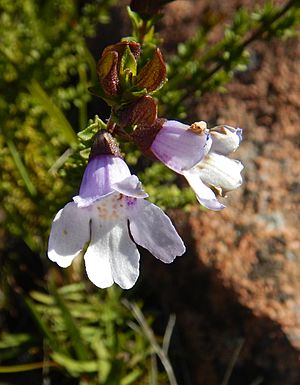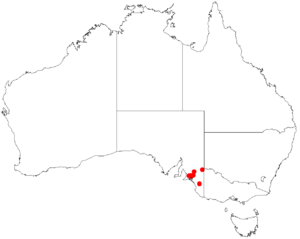Monarto mintbush facts for kids
Quick facts for kids Monarto mintbush |
|
|---|---|
 |
|
| In Mount Monster Conservation Park | |
| Conservation status | |
| Scientific classification | |
| Genus: |
Prostanthera
|
| Species: |
eurybioides
|
 |
|
| Occurrence data from AVH | |
The Prostanthera eurybioides, also known as Monarto mintbush, is a special type of flowering plant. It belongs to the Lamiaceae family, which includes mints. This plant is endemic to a small area in the south-east of South Australia. This means it only grows naturally in that specific region.
The Monarto mintbush is a small, spreading bush. It has branches covered in thick hairs. Its leaves are thick and shaped like an egg. They grow close together on short shoots. The flowers are a pretty violet to mid-purple color. Inside the flower tube, they are white with orange and dark purple dots.
What it Looks Like
The Monarto mintbush is a low, spreading shrub. It usually grows less than 1 meter (about 3 feet) tall and wide. Its branches are mostly round and covered in dense hairs.
The leaves are thick and shaped like an ellipse or an egg. They are very small, about 2 to 2.5 millimeters long and 1 to 2 millimeters wide. If you crush them, they smell strongly. The leaves grow in clusters on short shoots and do not have stalks.
The flowers grow one by one where the leaves meet the stem. Each flower sits on a tiny stalk about 0.5 to 1.5 millimeters long. The green parts under the petals, called sepals, form a tube. This tube is about 2.5 to 3 millimeters long and has two lobes.
The petals are about 10 to 12 millimeters long. They form a tube that is 6 to 7 millimeters long. The flowers are violet to mid-purple. Inside the tube, they are white with orange and dark purple dots. The lower part of the petal tube has three lobes. The middle lobe is shaped like a spatula. The upper part is egg-shaped with a small notch in the center. This mintbush flowers from September to November.
How it Got its Name
Scientists gave the Monarto mintbush its official name, Prostanthera eurybioides, in 1855. A scientist named Ferdinand von Mueller first described it. He wrote about it in his book called Definitions of rare or hitherto undescribed Australian plants.
Where it Lives
The Monarto mintbush grows in specific places in South Australia. You can find it near granite rocks in areas called mallee woodlands. These areas are around Monarto and Mount Monster Conservation Park.
Why it Needs Protection
The Monarto mintbush is an endangered plant. This means there are not many of them left in the wild. Both the Australian government and the South Australian government protect it.
Some of the main dangers to this plant include:
- Land clearing: When land is cleared for building or farming.
- Quarry operations: Mining for stone at Mount Monster.
- Weed invasion: Other plants taking over its habitat.
- Rubbish dumping: People leaving trash where it grows.
- Trampling: People walking on the plants.
- Trail bikes: Damage from off-road motorbikes.
These threats make it harder for the Monarto mintbush to survive and grow.


